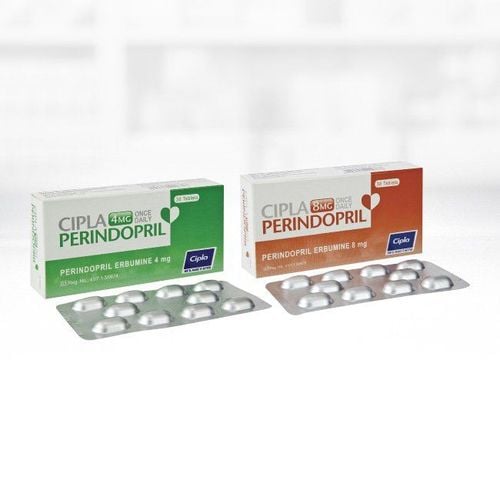This is an automatically translated article.
Normodipine 5mg drug belongs to the group of calcium channel blockers with the main ingredient amlodipine, usually indicated in cases of hypertension, chronic stable angina and spasmodic angina.
1. What does Normodipine 5 do?
Normodipine has the main ingredient amlodipine, a calcium antagonist of the dihydropyridine group (slow calcium channel blocker) that inhibits the influx of calcium ions across cell membranes into vascular smooth muscle and heart muscle. The antihypertensive mechanism of amlodipine is by its direct effect on vascular smooth muscle relaxation. In addition, the antianginal mechanism of amlodipine is to reduce ischemia by the following two effects:Amlodipine dilates peripheral arterioles, thereby reducing total peripheral resistance (reducing afterload). . Since heart rate is not affected, the reduction in cardiac load reduces energy consumption and oxygen demand. The mechanism of action of amlodipine can also cause dilation of the major coronary arteries and coronary arterioles, both in healthy and ischemic regions. This vasodilation will help increase oxygen delivery to patients with spasmodic angina (Prinzmetal's angina or variant angina). Thanks to the above effects, Normodipine is often indicated in cases of hypertension and myocardial ischemia accompanied by stable angina pectoris. Normodipine is contraindicated in the following cases:
Hypersensitivity to amlodipine, dihydropyridine derivatives or any component of the drug Severe hypotension Shock (including cardiogenic shock) Obstruction of the left ventricular outflow tract ( such as severe aortic stenosis) Hemodynamically unstable heart failure after acute myocardial infarction
2. Dosage of the drug Normodipine
Depending on the subjects and treatment goals, the dosage of Normodipine will be different, specifically as follows:
For adults:
Initial dose for treatment of hypertension and angina pectoris: 5mg amlodipine Once a day, the dose may be increased to a maximum of 10 mg depending on the response of the patient. Normodipine can be combined with thiazide diuretics, alpha-blockers, beta-blockers or angiotensin-converting enzyme inhibitors in the treatment of hypertension without Dosage adjustment is required For special subjects:
Elderly: the usual dose of normodipine is recommended in this population, but caution should be exercised when increasing the dose. Patients with hepatic impairment: caution when using normodipine for treatment, Patients with renal impairment: There is no correlation between the degree of renal impairment and changes in serum amlodipine concentrations. Therefore, the usual dose is still recommended in this population. Children and adolescents 16-17 years of age with hypertension: the recommended dose is 2.5 mg once daily, titrated up to 5 mg once daily if target blood pressure is not achieved. after 4 weeks. Currently, there are no recommendations for the use of normodipine in children under 6 years of age.
3. Normodipine side effects
In some patients when using Normodipine, side effects may occur such as:
Shortness of breath, wheezing, chest pain or shortness of breath Swelling of eyelids, lips Swelling of tongue, swelling of throat causing difficulty breathing Severe skin allergies including including severe skin rash, hives, red itchiness all over the body Heart attack, irregular heartbeat Pancreatitis can cause severe abdominal or back pain and discomfort
4. Be careful when using Normodipine
Some general notes when using Normodipine include:
Be careful when using amlodipine in patients with heart failure, because high pulmonary edema has been recorded. Amlodipine should be used in patients with hepatic impairment at a low dose in the dose range and with caution even at the start of therapy, increasing the dose Patients with renal impairment can use amlodipine at the usual dose, amlodipine not on dialysis Do not use Normodipine use in children under 6 years of age
5. Drug interactions with Normodipine
Some common drug interactions with normodipine include:
CYP3A4 inhibitors (ketoconazole, itraconazole, ritonavir) may increase blood levels of amlodipine greater than diltiazem Clarithromycin is a CYP3A4 inhibitor when co-administered with normodipine May increase the risk of hypotension Due to the risk of hyperkalemia, avoid concomitant use of calcium channel blockers such as amlodipine in patients susceptible to malignant hyperthermia and in the treatment of malignant hyperthermia Concomitant use of amlodipine and cimetidine do not change the pharmacokinetics of amlodipine Normodipine 5mg belongs to the group of calcium channel blockers with the main ingredient amlodipine, usually indicated in cases of hypertension, chronic stable angina and angina pectoris. contraction body. To ensure the effectiveness of treatment and avoid unwanted side effects, patients need to strictly follow the instructions of the doctor, professional pharmacist.
Follow Vinmec International General Hospital website to get more health, nutrition and beauty information to protect the health of yourself and your loved ones in your family.
Please dial HOTLINE for more information or register for an appointment HERE. Download MyVinmec app to make appointments faster and to manage your bookings easily.













